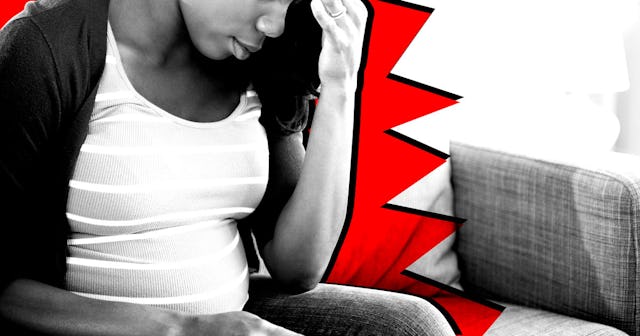Symphysis Pubis Dysfunction Can Make Pregnancy Even Harder

When I was pregnant with my first son, I spent a good bit of time in pain. I couldn’t walk properly. I waddled. And when I waddled, I cried. Regular, everyday activities caused me excruciating pain: I climbed stairs one leg at a time, like a toddler. I walked slowly, slowly, for short distances, and often ended up in tears. Putting on pants left me weeping. Getting in and out of bed required help. Forget the tub. Forget hiking. I gained a lot of weight because I simply couldn’t exercise: even the mobility required for swimming hurt too much.
My midwife, who brushed off most of my concerns, said it was relaxin in my joints and would pass. She was right, in a way. But she was also very wrong. I was suffering from a severe case of symphysis pubis dysfunction.
Let’s break it down. Symphysis pubis dysfunction, according to Healthline, occurs to some extent in 1 in 5 pregnant women. It refers to pain in “the front center of your pubic bone … your lower back on one or both sides … [and/or] the area between the anus and vagina.”
I hurt in my lower back, on both sides, and the front of my pubic bone, and boy did I hurt. Like, I-can’t-move kind of hurt. I felt like my joints were somehow set in my body wrong, like my hips would somehow hyper-rotate or something. I kept trying to stand on one leg to eliminate pain in the other, then shifting when the pain became too much.
Vanessa Alin/Reshot
This pain is caused by the hormone relaxin, which you need when you’re pregnant. Relaxin is produced by your placenta and ovaries, and it relaxes the ligaments in your pelvis and softens and widens the cervix. Obviously it’s important for childbirth when you’re, as the saying goes, passing something the size of a small watermelon through an opening normally the size of a lemon (it’s not quite like that, but you get the picture. Clearly, you need relaxin).
Healthline says relaxin is supposed to “increase your range of mobility” to help you give birth, loosening your joints so baby can pass through your pelvis more easily. Sounds good. Except in some women, this loosening of the joints — and subsequent spreading of your hips — can become extremely painful. “Your joints can become unbalanced and more mobile than they usually would be,” says Healthline.
And the (not so) great news: symphysis pubis dysfunction often gets worse as your pregnancy progresses.
Believe me, being seriously pregnant and not able to walk, especially when your midwife is yelling at you to exercise? It seriously sucks.
Treating symphysis pubis dysfunction requires that you first realize your pain is not normal. I didn’t, because my care practitioner brushed me off. Major issue. You need a supportive doctor, and you need to tell that supportive doctor (if they can’t already tell when you cry getting up on the exam table) how much pain you’re in.
A 2008 British study in the The Obstetrician and Gynecologist suggested physical therapy, including elevated toilet seats (yeah, it hurts to get out of chairs, hence it hurts to get up off the toilet), and acupuncture — with acupuncture being more effective. So even if your doctor won’t refer you to a physical therapist, you can get acupuncture on your own. Pricey — but if it stops your crying when you put on your pants on your pants in the morning, it might be worth the expense.
Water gymnastics and a special pillow helps improve symphysis pubis dysfunction, the study also found (I used a regular pillow between my legs out of instinct, and even that seemed to help), as did a “pelvic belt and muscle strengthening exercises.” I wore a pelvic belt or back brace, which you can buy at most any baby store, and that helped me immensely. Another study recommended chiropractic care as effective.
I was lucky: my pain went away before delivery — miraculously! — though I had terrible back labor; it didn’t persist after delivery. But for many women, symphysis pubic dysfunction continues after delivery, though symptoms usually lessen after giving birth. I had several anecdotal factors in my favor. I was babywearing constantly, an exercise which probably helped with my balance and mobility. I also wore a post-pregnancy girdle 24/7, which probably provided much-needed back and hip support. But other women aren’t so lucky.
One study discussed two women whose pain persisted for up to eleven months after delivery. One woman was prescribed several exercises and mostly healed, though at the “long-term twelve-month post-partum follow-up, she reported being mostly pain free.” Um, ouch. One postpartum treatment program had women exercise for “30–60 minutes, 10 repetitions per exercise, 3 days per week for 18–20 weeks.” That’s great, but I didn’t have time for that after I had a baby.
Despite the fact that I had a pretty severe case of symphysis pubis dysfunction, mine never persisted — nor recurred in subsequent pregnancies. So there’s hope, folks. Don’t get discouraged.
However you slice it, though, symphysis pubis dysfunction is real. It’s painful.
And it sucks.
This article was originally published on